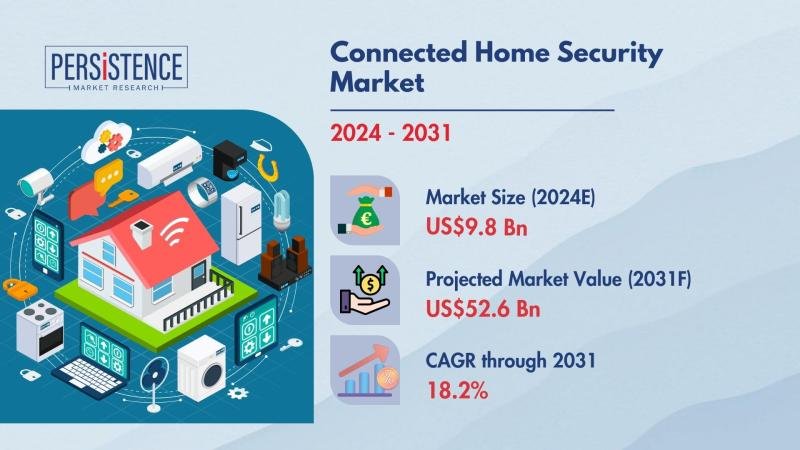✅Market Overview and Growth Dynamics
The global connected home security market is experiencing rapid growth, driven by an increasing need for smart, reliable, and real-time home monitoring solutions. According to Persistence Market Research, the market was valued at approximately US$ 9.8 Billion in 2023 and is projected to reach a staggering US$ 52.6 Billion by 2033, registering a robust CAGR of 18.2% during the forecast period.
A major driver behind this surge is the rising adoption of smart homes globally. Homeowners are increasingly integrating Internet of Things (IoT)-enabled devices, such as smart locks, smart cameras, and motion sensors, into their security systems. Growing consumer awareness about digital threats and the importance of proactive home security is also bolstering demand. Among all the segments, internet security cameras remain the leading device category, thanks to their accessibility, cloud storage capabilities, and 24/7 remote monitoring.
Get a Sample PDF Brochure of the Report (Use Corporate Email ID for a Quick Response): https://www.persistencemarketresearch.com/samples/29833
North America currently dominates the global connected home security market. This leadership position is largely attributed to high smart home adoption rates, strong consumer purchasing power, and the presence of leading tech companies. Moreover, U.S. households are more receptive to early tech adoption, giving this region a strategic edge in both consumption and innovation.
✅Key Highlights from the Report
➤ The connected home security market is projected to grow at an 18.2% CAGR from 2023 to 2033.
➤ Internet security cameras dominate the connected devices segment due to increased remote monitoring needs.
➤ North America holds the largest market share owing to widespread smart home adoption.
➤ Software/platform components represent the fastest-growing segment.
➤ Rising concerns about phishing and online fraud are fueling market expansion.
➤ Growing demand for unified, app-based home security control systems is reshaping market dynamics.
✅Market Segmentation
The connected home security market is segmented based on component, connected devices, and application. On the component front, the market includes software/platform, services, integration & deployment, training & consulting, and maintenance & support. The software/platform segment is gaining significant traction due to the increasing need for centralized control and management of multiple smart security devices via mobile applications.
When it comes to connected devices, the key categories include smart TVs, smart thermostats, smart speakers, smart locks, and internet security cameras. Among these, internet security cameras are the most sought-after devices due to their growing affordability, compatibility with home networks, and AI-based features such as motion detection and facial recognition. Other devices like smart locks and smart speakers are also witnessing growing adoption as homeowners look for seamless integration with existing systems.
By application, the market is categorized into intrusion & anti-malware protection, device detection & management, phishing & fraud prevention, network security, and others. Intrusion and network security remain the most critical applications, especially in urban areas where home automation is more prevalent. As homes become more connected, managing vulnerabilities across all endpoints becomes essential.
✅Regional Insights
North America leads the global connected home security market due to high smart device penetration and awareness about cyber and physical threats. The United States is the primary contributor, supported by rapid IoT adoption, favorable government initiatives, and technological advancements by homegrown firms like Cisco, Honeywell, and McAfee. Consumers in this region prioritize convenience, energy efficiency, and safety, all of which are delivered by modern connected security systems.
In contrast, Asia-Pacific, particularly China, Japan, and South Korea, is emerging as a high-growth region. Rising urbanization, improved internet infrastructure, and growing middle-class income levels are creating a fertile environment for smart home solutions. Government efforts in smart city development and digital transformation are also fostering this market. India is also a notable emerging market, thanks to the rise in tech-savvy millennials and increased e-commerce penetration.
✅Market Drivers
One of the primary drivers of the connected home security market is the rising concern for home safety and data privacy among consumers. With increasing media coverage of home intrusions, thefts, and cyberattacks, homeowners are turning to proactive monitoring solutions. The affordability of cloud storage and mobile connectivity further enables 24/7 access to real-time footage and alerts.
Additionally, the expansion of IoT ecosystems has been a catalyst for market growth. Devices are now smarter, interoperable, and energy-efficient, driving adoption. The availability of DIY (Do-It-Yourself) security kits has also made it easier for users to deploy systems without professional help, reducing installation barriers.
✅Market Restraints
Despite the optimistic outlook, several restraints limit market expansion. A key challenge is the concern around data breaches and hacking. As connected systems become more complex, they become vulnerable to cyber threats. Consumers may hesitate to adopt these solutions due to a lack of trust in the security protocols of cloud services and devices.
Furthermore, the high upfront cost of advanced connected security solutions can deter adoption, especially in price-sensitive regions. Integrating devices from different brands often results in compatibility issues, leading to a fragmented user experience. These technical hurdles can impact consumer confidence and slow market growth.
✅Market Opportunities
The evolving nature of threats and consumer demand presents several growth opportunities. Artificial Intelligence (AI) and machine learning integration into home security systems can provide predictive analytics, behavioral pattern detection, and more responsive systems. These intelligent solutions can differentiate market leaders in a competitive landscape.
Moreover, subscription-based services are gaining popularity, offering scalable and affordable security solutions to homeowners. Companies that provide bundled services, combining devices, cloud storage, and maintenance under one plan, can gain long-term customer loyalty. Emerging economies also offer significant opportunities due to rising disposable incomes and increased digital penetration.
For Customized Insights on Segments, Regions, or Competitors, Request Personalized Purchase Options @ https://www.persistencemarketresearch.com/request-customization/29833
✅Frequently Asked Questions (FAQs)
➤ How Big is the Connected Home Security Market?
➤ Who are the Key Players in the Global Market for Connected Home Security?
➤ What is the Projected Growth Rate of the Connected Home Security Market?
➤ What is the Market Forecast for Connected Home Security for 2033?
➤ Which Region is estimated to dominate the Connected Home Security Industry through the Forecast Period?
✅Company Insights
✦ D-Link Corporation
✦ Symantec Corporation (Broadcom)
✦ Commscope (ARRIS)
✦ Cisco Systems, Inc.
✦ F-Secure Corporation
✦ Avast Software
✦ Trend Micro
✦ Honeywell International Inc.
✦ McAfee, LLC
✦ Bitdefender
✅Recent Market Developments
■ In 2023, Honeywell launched a new AI-powered home security solution that integrates with Google Assistant and Alexa, allowing users to monitor and control systems via voice commands.
■ Cisco Systems announced a strategic partnership with a leading smart home startup to enhance interoperability between IoT devices and cloud-based security networks.
The connected home security market is poised for transformational growth, driven by a combination of technological innovation, changing consumer preferences, and increasing awareness of home and cyber safety. Companies that can offer integrated, secure, and user-friendly solutions will lead the way in this dynamic and expanding market.
✅Explore the Latest Trending “Exclusive Article” @
• https://www.manchesterprofessionals.co.uk/article/marketing-pr/91544/cooling-fabrics-market-technological-advancements-to-watch
• https://apnewswire.hashnode.dev/cooling-fabrics-market-applications-in-sportswear-and-athleisure
• https://industrynewswire.substack.com/p/cooling-fabrics-market-innovations
• https://hackmd.io/@apnewswire/HJnbxk6Zex
• https://www.instagram.com/p/DJ9yWeOiCir/
✅Contact Us:
Persistence Market Research
G04 Golden Mile House, Clayponds Lane
Brentford, London, TW8 0GU UK
USA Phone: +1 646-878-6329
UK Phone: +44 203-837-5656
Email: sales@persistencemarketresearch.com
Web: https://www.persistencemarketresearch.com
✅About Persistence Market Research:
At Persistence Market Research, we specialize in creating research studies that serve as strategic tools for driving business growth. Established as a proprietary firm in 2012, we have evolved into a registered company in England and Wales in 2023 under the name Persistence Research & Consultancy Services Ltd. With a solid foundation, we have completed over 3600 custom and syndicate market research projects, and delivered more than 2700 projects for other leading market research companies’ clients.
Our approach combines traditional market research methods with modern tools to offer comprehensive research solutions. With a decade of experience, we pride ourselves on deriving actionable insights from data to help businesses stay ahead of the competition. Our client base spans multinational corporations, leading consulting firms, investment funds, and government departments. A significant portion of our sales comes from repeat clients, a testament to the value and trust we’ve built over the years.
This release was published on openPR.

















